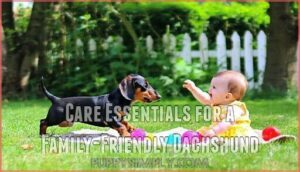This site is supported by our readers. We may earn a commission, at no cost to you, if you purchase through links.

However, their delicate spines mean you’ll need to teach your kids proper handling techniques from day one. Think of it like having a playful friend who needs extra care – no picking up incorrectly or allowing rough play.
Early socialization is key, and yes, they can be stubborn during training, but patience pays off. The secret lies in understanding their unique needs and creating safe interaction boundaries that protect everyone involved.
Table Of Contents
- Key Takeaways
- Are Dachshund Puppies Good With Kids?
- Key Dachshund Traits for Families
- Safety Considerations for Kids and Dachshunds
- Training and Socializing Dachshund Puppies
- Care Essentials for a Family-Friendly Dachshund
- Frequently Asked Questions (FAQs)
- What age is best to introduce a dachshund puppy to kids?
- How can I teach my kids to properly handle a dachshund puppy?
- Are dachshunds good with babies and toddlers?
- What age should kids be around dachshund puppies?
- How do dachshunds react to crying babies?
- Can dachshunds live in apartments with children?
- Do dachshunds get jealous of new babies?
- What toys work best for kids and dachshunds?
- Conclusion
Key Takeaways
- You’ll need to teach proper handling from day one – Dachshund puppies have delicate spines that can be injured by incorrect lifting or rough play, so showing kids how to support their chest and hindquarters is crucial for safety.
- Early socialization between 8-16 weeks creates the best outcomes – Introducing your dachshund puppy to children during this critical window helps them form positive associations and builds the foundation for lifelong friendships.
- You can expect protective instincts and stubborn training moments – These loyal pups will bark to protect your family but may test boundaries during training, requiring patience and consistent positive reinforcement techniques.
- Supervision is essential, especially with kids under 6 – While dachshunds can be wonderful family companions, their small size and protective nature mean you’ll need to actively monitor interactions until both children and puppy learn appropriate behavior.
Are Dachshund Puppies Good With Kids?
You’ll find that Dachshund puppies can make wonderful companions for kids when you introduce them early and teach proper handling techniques.
These curious, playful pups form strong bonds with family members, but they need gentle treatment due to their delicate backs and can be protective around strangers.
Typical Dachshund Temperament Around Children
Dachshund puppies usually show curious, friendly behavior around children, forming strong bonds through early socialization. Their naturally protective instincts make them loyal family companions, though individual Dachshund temperament varies.
Proper puppy development involves positive child interaction experiences. These family pets demonstrate playful canine behavior when raised with kids, creating lasting family dynamics that benefit both children and Dachshund breed members.
Pros and Cons of Dachshunds as Family Pets
While these loyal pups make wonderful Family Pets, the Dachshund Dog Breed comes with trade-offs. Their Pet Adaptability shines in apartments, but Dachshund puppies can be stubborn during training.
Family Dynamics improve with their protective nature, yet their fragile backs require careful Child Interaction. Breed Compatibility depends on your patience for Household Integration and commitment to proper Dachshund Care. Understanding dog socialization techniques is vital for a harmonious household.
Realistic Expectations for Kids and Puppies
Setting realistic expectations helps prevent disappointment when bringing home your Dachshund puppy. Household Adaptation takes weeks, not days. Your Dachshund puppy needs consistent Dachshund Training before becoming the perfect family companion you’re hoping for.
Kids need patience during Puppy Socialization periods, as your Dachshund dog won’t instantly love roughhousing. Family Dynamics require adjustment time—expect some nipping, accidents, and testing boundaries.
Child Safety Tips include teaching gentle handling early.
Key Dachshund Traits for Families
You’ll want to understand your dachshund puppy’s natural traits before bringing one home to your family. These energetic little hounds pack big personalities into their sausage-shaped bodies, combining playful curiosity with surprisingly strong protective instincts that make them both delightful companions and effective watchdogs.
Energy Levels and Playfulness
Your Dachshund puppy brings bursts of playful energy that’ll keep your kids entertained. These mini dynamos need daily stimulation through fun activities like fetch and hide-and-seek.
A solid playtime routine helps manage their temperament—think short, intense sessions followed by rest. Energy balance is key for these playful mini Dachshund characteristics.
To guarantee a harmonious household, making sure to understand proper training techniques for your Dachshund.
Protective Instincts and Watchdog Behavior
Your dachshund’s natural guard dog traits make them excellent family protectors, but their barking habits need management. These alert systems kick in quickly around strangers, showcasing their protective measures through vocal warnings. Watchdog training helps channel their temperament positively while addressing potential dachshund health problems from stress-related behaviors.
- That fierce loyalty – Your dachshund will sound the alarm before danger reaches your doorstep
- The midnight guardian – Sleep peacefully knowing your little sentinel never truly rests
- Your personal early warning system – Visitors can’t sneak past those radar-sharp ears
- The brave defender – Despite their size, they’ll face down threats twice their weight
- Your family’s voice – They bark not from aggression, but from pure protective love
Size Differences: Standard Vs. Miniature
When choosing between breed variations, consider your living situation carefully. Standard Dachshunds weigh 16-32 pounds, while Mini Dachshunds stay under 11 pounds.
This Size Comparison matters for families—Miniature Dachshunds need gentler handling around small children, while Standard Training often proves easier.
Space Requirements vary too. Your Miniature Dachshund adapts better to apartments, but both sizes make excellent family companions with proper Miniature Care considerations.
Safety Considerations for Kids and Dachshunds
When you bring a dachshund puppy into your home with children, you’ll need to focus on protecting their fragile spine while teaching kids proper interaction techniques.
Your puppy’s long back makes them vulnerable to serious injury from improper lifting, jumping, or rough play that might seem harmless with other breeds.
Preventing Back Injuries in Puppies
Your dachshund puppy’s elongated spine makes them vulnerable to intervertebral disk disease (IVDD). Protecting their back starts with smart choices about activities and handling.
Puppy Spine Care basics:
- Limit jumping – Keep puppies off furniture and use ramps instead
- Control stair access – Block stairs with baby gates until maturity
- Practice gentle handling – Support chest and rear when lifting
- Choose low-impact exercise – Short walks beat rough play sessions
- Watch for warning signs – Monitor for reluctance to move or yelping
These spinal health tips prevent costly injuries and keep your pup comfortable for life. Regular back care checks are essential to identify potential issues before they become serious.
Supervising Interactions With Young Children
Without proper parental guidance, even friendly dachshund puppies can accidentally harm children. Family Dynamics improve when Pet Ownership includes clear boundaries. You’ll need active supervision strategies during Kid Friendly Activities to guarantee both parties stay safe.
| Age Group | Supervision Level |
|---|---|
| Under 5 years | Direct, constant monitoring |
| 5-8 years | Close supervision with guidance |
| 9+ years | Periodic check-ins |
This Dachshund Breed Overview emphasizes Child Safety Tips for successful Family Dogs integration.
Teaching Children Proper Handling
You’ll want to teach your kids gentle touch techniques when handling your mini dachshund puppy. Show them how to support the puppy’s chest and hindquarters—never lift by the scruff or limbs. Demonstrate slow movements and quiet voices.
Use positive reinforcement when children follow proper handling techniques. Remember, safety precautions during child supervision protect both your dachshund and your kids. Proper puppy care products can also help guarantee a safe environment for your pet.
Training and Socializing Dachshund Puppies
Training your dachshund puppy around kids takes patience and consistency, but the payoff is huge when you see your little sausage dog playing gently with your children. You’ll want to start socialization early and use positive reinforcement techniques to shape the friendly, well-behaved family companion you’re hoping for.
Early Socialization With Kids
Building social bonds between your Dachshund puppy and children starts early. Kid-friendly training works best when puppies meet kids during their first few months. This shapes their temperament and creates positive family dynamics. Mini Dachshund puppies especially benefit from gentle child interactions that build trust and comfort.
- Start introductions when puppies are 8-16 weeks old for ideal social bonding
- Let children offer treats during puppy interaction sessions to create positive associations
- Practice child safety tips by teaching kids to sit quietly while puppies approach them
- Schedule regular playtime where children and puppies can bond under your watchful eye
Positive Reinforcement Training Techniques
Once your mini Dachshund puppy knows basic socialization, dog training becomes smoother with reward systems. Use clicker training paired with high-value treats for puppy obedience success.
Dachshund puppies respond well to behavioral modification through consistent praise and patience. Short, frequent sessions work best for housebreaking tips and commands.
Remember, these clever pups learn faster when training feels like a fun game rather than work.
Tips for Managing Stubborn Behavior
Your Dachshund’s stubborn streak isn’t personal—it’s genetics. When positive reinforcement hits a wall, mix up your reward training approach. Use higher-value treats during behavioral correction sessions. Consistent boundaries work better than repeated commands.
Patient guidance beats frustration every time. Keep training sessions short but frequent. An exercise routine before dog training helps burn off that defiant energy that makes puppies test limits. Effective basic obedience training is essential for managing stubborn behavior in Dachshund puppies.
Care Essentials for a Family-Friendly Dachshund
You’ll need to establish consistent daily routines that keep your Dachshund healthy while fitting seamlessly into your family’s busy schedule. The right balance of exercise, grooming, and nutrition won’t just prevent common health issues—it’ll help your pup become the well-behaved family companion you’re hoping for.
Exercise Needs and Mental Stimulation
Energy is your dachshund puppy’s secret weapon for family harmony. These spirited pups need two daily walks and interactive playtime activities to prevent destructive behaviors around kids. Mental stimulation through puzzle toys keeps their clever minds occupied while building positive associations with children during exercise routines. Providing the right Dachshund toys is essential for their development and happiness.
- Daily walks: Two 30-minute sessions help burn excess energy
- Interactive games: Hide-and-seek with kids builds bonds safely
- Puzzle toys: Challenge their intelligence during quiet family time
- Training sessions: Short 5-10 minute exercises strengthen obedience
Grooming and Health Maintenance
Regular grooming keeps your Dachshund healthy and family-ready. Brush their coat weekly to prevent matting and shedding around kids. Nail trimming every 2-3 weeks prevents scratches during play. Clean ears monthly to avoid infections.
Daily dental care prevents bad breath and gum disease. Schedule routine health checks to catch conditions early, especially back problems common in Dachshunds. Understanding dog grooming techniques is essential for maintaining their overall health and well-being.
Diet and Preventing Obesity
Proper nutrition plans form the foundation of your Dachshund’s wellbeing. Create feeding schedules with measured portions to maintain calorie control and prevent weight gain. Choose balanced diets with high-quality pet nutrition that enhances their unique body structure.
Offer healthy snacks sparingly—carrots or apple slices work well. Monitor your dog’s weight regularly, as excess pounds strain their vulnerable spine and can worsen health conditions.
Frequently Asked Questions (FAQs)
What age is best to introduce a dachshund puppy to kids?
You’ll want to start socializing your dachshund puppy with children around 8-12 weeks old. This sweet spot allows proper vaccinations while capturing their critical socialization window for positive experiences.
How can I teach my kids to properly handle a dachshund puppy?
Teach children to support the puppy’s body when lifting, avoiding the back area. Show them gentle petting techniques and encourage quiet voices.
Supervise all interactions closely, emphasizing the puppy’s fragile spine needs careful handling.
Are dachshunds good with babies and toddlers?
Dachshunds can be wonderful with babies and toddlers when properly socialized early. However, you’ll need constant supervision since their delicate backs make them vulnerable to accidental injury from little ones.
What age should kids be around dachshund puppies?
Children aged 6 and older work best with dachshund puppies. They’re old enough to understand gentle handling and respect the puppy’s fragile spine, while young enough to form lasting bonds.
How do dachshunds react to crying babies?
Your dachshund will likely show curiosity about crying babies rather than aggression. They’re naturally protective but may bark initially at unfamiliar sounds.
Proper introduction and supervision help them adjust peacefully to your baby’s presence.
Can dachshunds live in apartments with children?
Yes, you can successfully raise dachshunds in apartments with children. They adapt well to smaller spaces when given daily walks and interactive play. Their compact size makes them apartment-friendly companions.
Do dachshunds get jealous of new babies?
Studies show 2-year-old infants experience jealousy, so your dachshund likely can too.
Yes, they’re naturally possessive of their owner’s attention and may compete with your new baby for the spotlight they once enjoyed.
What toys work best for kids and dachshunds?
Interactive puzzle toys like treat-dispensing balls keep both engaged safely. Soft plush toys work well for gentle play together. Avoid small parts that create choking hazards for either.
Conclusion
Like a bridge connecting two worlds, are dachshund puppies good with kids depends on building that connection carefully. These devoted companions can become your child’s best friend when you establish proper handling rules, consistent training, and supervised interactions.
Their protective nature and playful spirit make them wonderful family dogs, but their delicate backs require respect. With patience and preparation, you’ll create a lasting bond that brings joy to everyone in your household.














